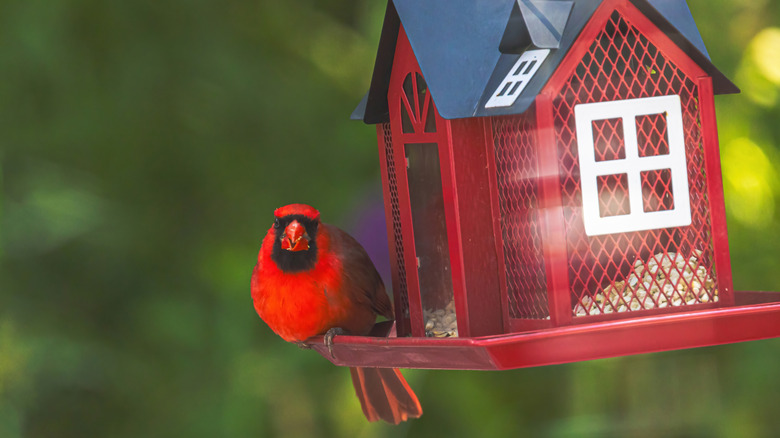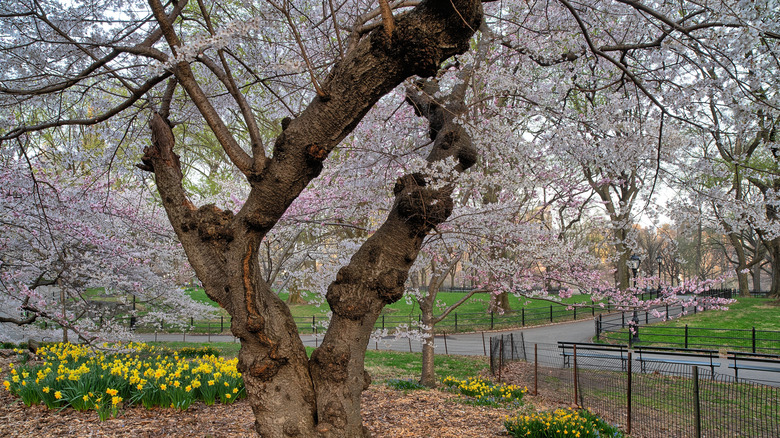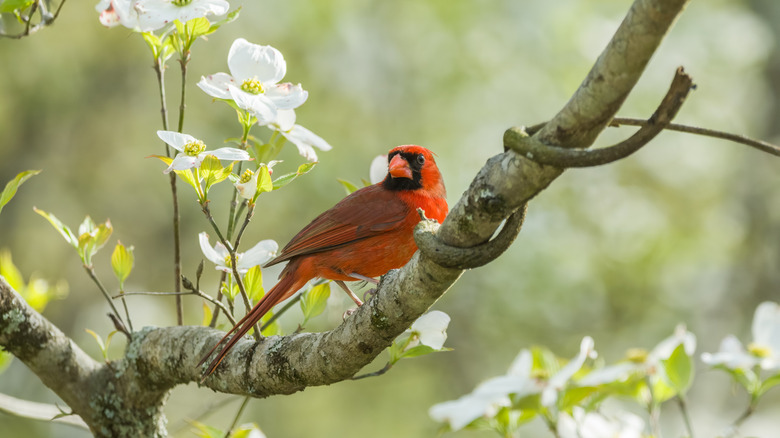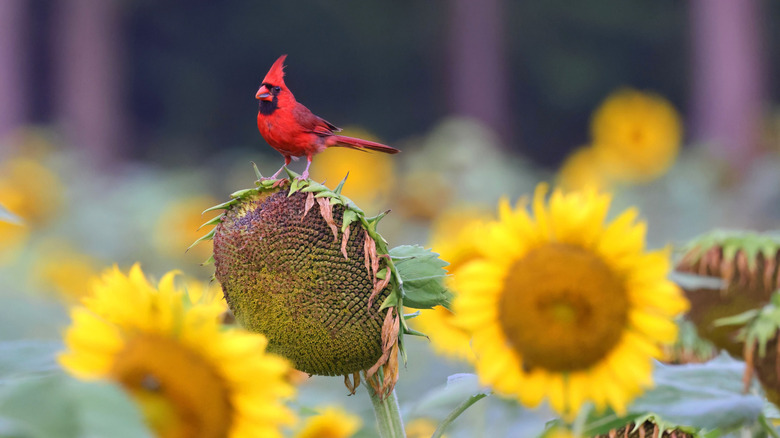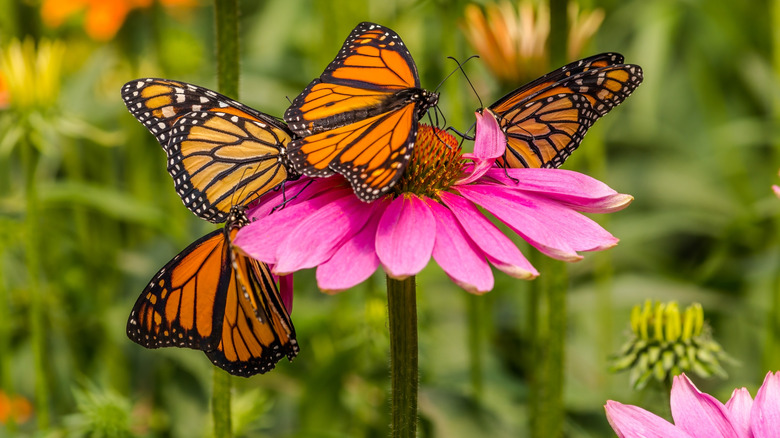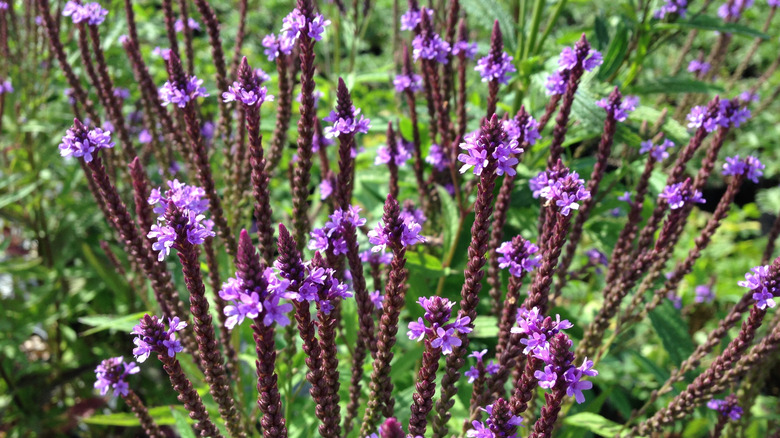Attract Cardinals To Your Yard With The Help Of These Easy-To-Grow-Plants
Birds and plants have a unique relationship. Many fruit-bearing flora rely on flying animals to pollinate flowers and disperse seeds. Birds get a benefit as well, namely in having an easy source of food. Because of their mutually beneficial relationship, they have participated in something known as co-evolution, which allows them to adapt and grow together to continue their relationship and make life a little easier for both sides.
This evolution means that certain plants grow more attractive to specific species of birds. For example, if you want to appeal to a cardinal over a hummingbird, you'll need some specific flowers. If you are trying to bring in both, there are several stunning plants perfect to attract hummingbirds to your garden as well. However, cardinals tend to live in the woodlands found in the United States. This means you don't need to go looking at exotic plants to try and entice cardinals — instead, focus on bringing in flowers into your yard that they would see in their normal habitat, which is to say, woodland plants.
However, this means that the most obvious ones to grow are trees. Unfortunately, they aren't always the best plants to put in your yard, especially if you're limited in space. Thankfully, while these big, towering plants are a surefire way to land cardinals in your yard, several flowers and shrubs will catch their attention as well.
Sweet crabapple (Malus coronaria)
If you are looking for a tree that will look beautiful in your yard and also attract cardinals, you can't go wrong with crabapple trees, especially Malus coronaria. In addition to this species, there are two others native to the United States; M. fusca and M. ioensis. Each one makes its home in slightly different parts of North America, so if the sweet crabapple doesn't work in your area, look at some of the other local ones. Each one has many positives that attract people and birds to them.
Crabapples are not only attractive to cardinals, but they are a pleasant plant to have growing in your yard. They are related to roses, and in spring when their stunningly beautiful blooms appear, they release a pleasant floral fragrance as well. After spring is over and the flowers start to die, fruits appear, which are the crabapples that give the plant its name. These are what attract cardinals and other animals to your home. To bring your backyard to life with a variety of different wildlife, let at least some of the fruits ripen naturally and fall off of the branches. However, you can harvest a few of them for yourself. The fruits are too bitter to eat raw, but they do make delicious drinks, syrups, and jams.
While adding certain plants to your yard is certainly a way to attract songbirds like cardinals to your home, it's not the only option. Setting out bird feeders with the right type of food and baths are other simple methods for attracting more songbirds to your yard and garden. By growing a mix of the cardinal's favorite plants and scattering a few feeding stations around your yard, you're sure to be the hotspot for various bird species.
Flowering dogwood (Cornus florida)
Dogwoods are another tree highly attractive to cardinals. The flowering dogwood is one of several species that would look stunning in any yard. In fact, some people consider these trees to be one of the most beautiful of the native species in the United States.
The flowering dogwood is also found in much of the country, especially east of Kansas, making it an ideal plant to grow. Like with crabapples, cardinals prefer most dogwoods, so if this one doesn't work for you or struggles to grow in your zone, you have plenty of other options. There are a total of 12 species native to the United States and Canada, and while Cornus florida is considered by many to be the most beautiful, it's not the only gorgeous one.
Dogwoods prefer a lot of water, so they're a great tree to grow if you have an area of your yard that tends to stay pretty moist, or near a creek or pond. If you live in a dryer climate you may struggle to keep up with this plant, and may want to consider a different option to attract cardinals. Another potential downside is that flowering dogwoods attract a wide range of other bird species, including several common birds you never want to see at your bird feeder, like grackles and crows. Thankfully, if this one doesn't work out, there are still plenty of other flowering plants to try out.
Sunflowers (Helianthus)
In addition to trees, there are also several flowers that will have cardinals flocking to your yard. One of the easiest to care for, and the most obvious, are sunflowers. After all, sunflower seeds are something you'll come across frequently in bird seed because they are so delicious to many different species. While some flowers draw the attention of specific birds, sunflowers tend to attract almost any kind, especially ones that primarily eat seeds.
There are over 50 different species of sunflowers native to North America and parts of Mexico, so you have plenty of choices when it comes to figuring out which ones to grow in your garden. Some are tall and the classic yellow color, while a few species are under three feet, and others still come in brilliant shades of red and orange. With so many choices, it's hard to pick a favorite or most popular one, but if you are overwhelmed by the options, you can't go wrong with Helianthus annuus, or the common sunflower. Sunflowers are annuals, but if you let their seeds drop and spread, they will come back year after year.
It's worth mentioning that while these plants are great options for those looking to attract cardinals, they aren't the only ones. For example, if you're wanting a slightly different plant, there is a gorgeous berry bush that brings in all the cardinals to your yard. Additionally, in the winter, you can switch loose bird seed for these DIY suet cakes to keep birds coming year-round.
Purple coneflower (Echinacea purpurea)
Purple coneflowers not only attract birds as a food source, but because they also draw in insects. Even for songbirds that love seeds, bugs are a delicious option and an additional food source. It's not just the annoying ones that find purple coneflowers irresistible, bees and butterflies also love these flowers and tend to gravitate towards them. In addition to cardinals, juncos, chickadees, and goldfinches enjoy purple coneflowers, so planting a few of them will fill your yard with songbirds. Because they are native to the United States and do such a great job attracting insects and birds, they are considered one of the best wildflowers to plant in a yard, garden, or green space to support pollinators.
There are nine species of coneflowers, which are all primarily native to North America, especially the eastern and central prairies. While you can use any of them, the purple coneflower is one of the most common and abundant, as well as the easiest to buy. However, there are a few other choices, depending on where you live, including the prairie, Ozark, and the pale purple coneflower.
They're not the most attractive in the winter, turning into dark seed balls, but for the month or so they bloom, your yard will be covered in beautiful flowers and stunning wildlife. Though not super attractive, try and leave the heads standing in the winter, as these are a prime food source for a wide range of birds. Coneflowers are one of the plants you want to avoid pruning in the fall.
Blue vervain (Verbena hastata)
Also known as swamp verbena, the blue vervain is a perennial plant in certain conditions. The plants are long with tubular, purpley-blue flowers clustered in spikes. They are tall, growing up to five feet high, adding a fun and still-colorful height difference to add some depth to a garden. This plant has quite a few positives. Not only does it attract several kinds of birds, including cardinals, but it is low maintenance, bee-friendly, and resistant to deer. It's also native to a majority of the United States. Sometimes, it's considered a weed because it grows in pastures and livestock don't like it. However, it's not an aggressive plant, and is regularly outcompeted by other perennial plants.
If you're not a fan of this species of verbena, you're spoiled for choice. There are over 80 different options throughout the world, and many of them are found in the United States. They come in a wide range of colors and sizes, so you can really find one that fits your garden best. Most of the varieties have blooms from the moment they're planted until the first frost, attracting all sorts of birds and other pollinators besides simply cardinals. They're also pretty durable, and do well in most of the United States, though USDA zones 7 through 11 are where they really thrive.
